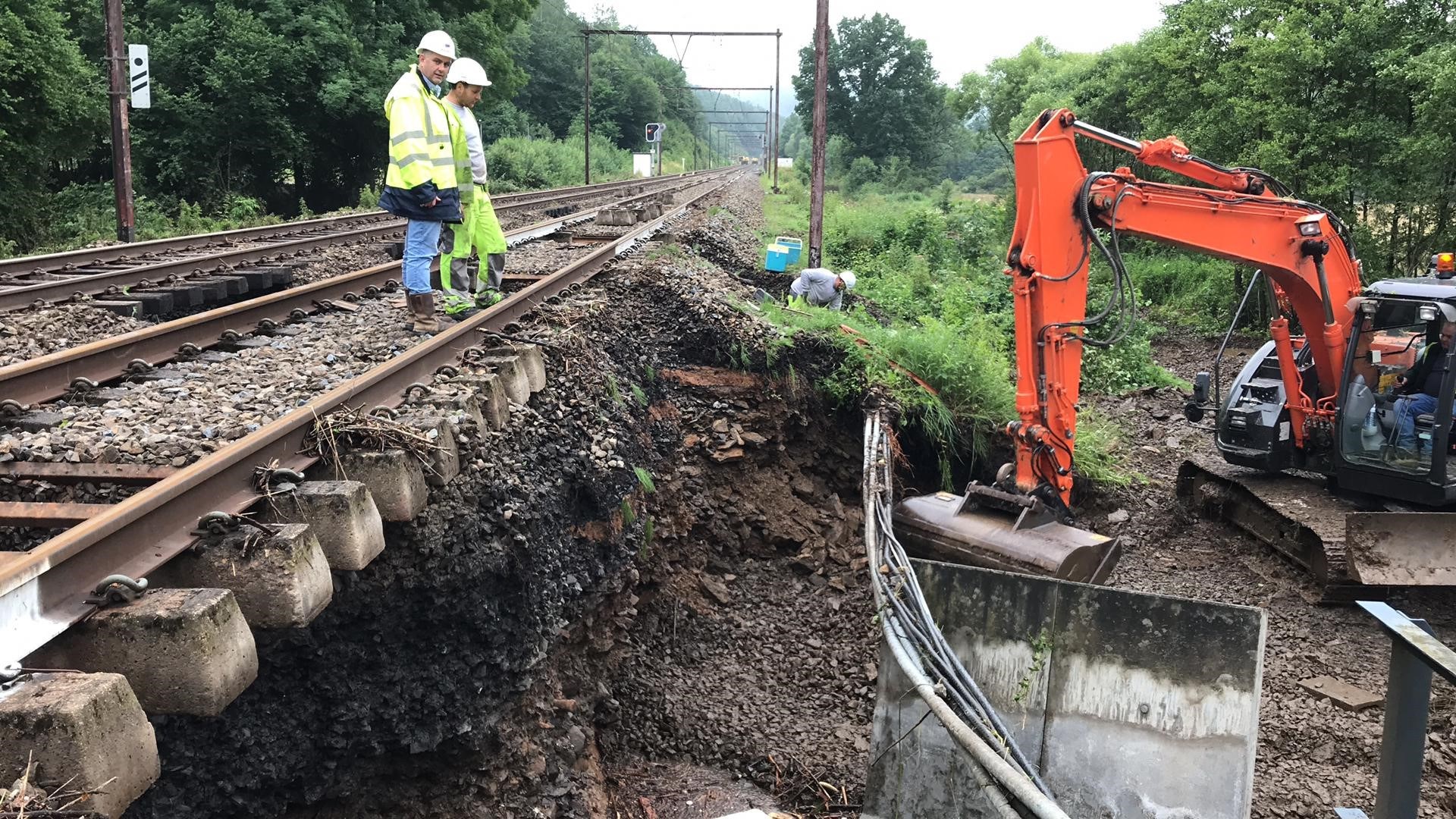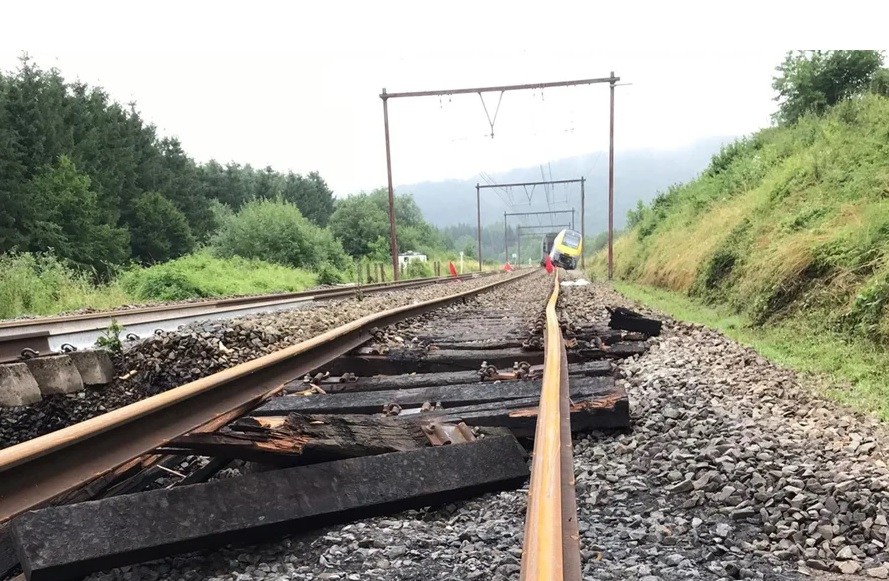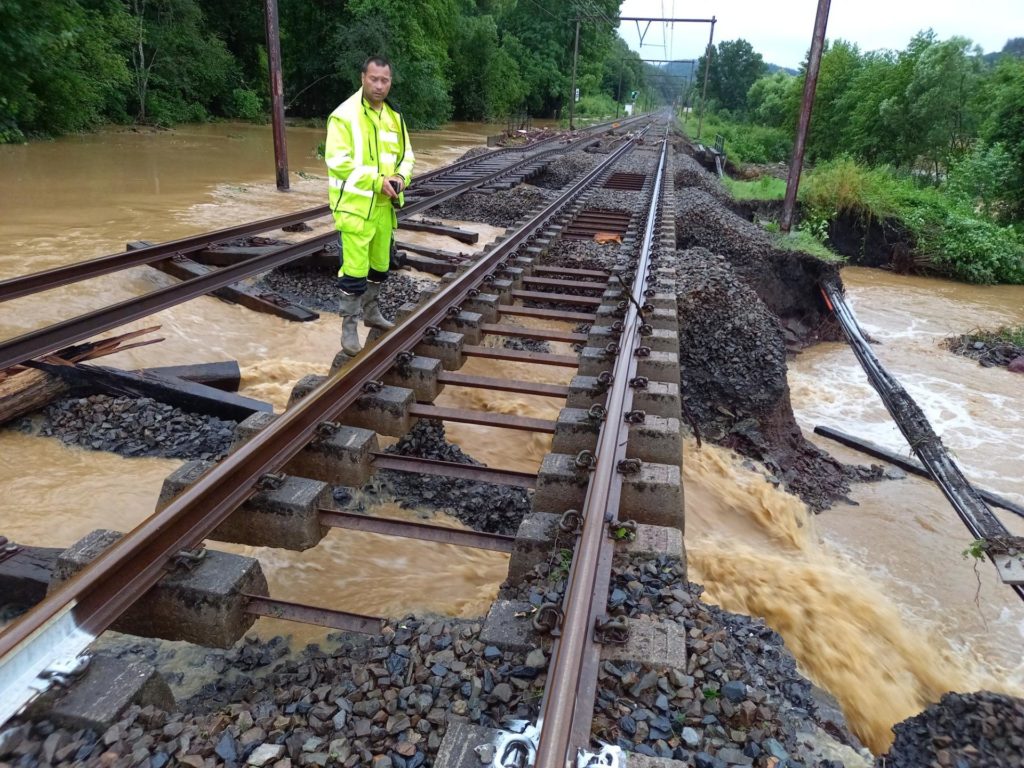The Belgian national rail company SNCB and rail infrastructure company Infrabel have set up a plan to restore rail traffic in Wallonia line by line following the devastating floods that swept the region last week.
Heavy rainfall and mass flooding across Belgium resulted in multiple deaths and thousands of houses being damaged or collapsing, and the severe weather also disrupted rail traffic and damaged the railway infrastructure.
Many lines are blocked, a bridge has collapsed, mudslides have washed away the ballast in many places and several sections are no longer passable due to the collapse of the embankment on which the tracks rest, according to the agencies.
Several engineering structures were also weakened and electrical installations damaged.
“In the coming days, the exact extent of the damage will become clear,” said Georges Gilkinet, the Federal Minister for Mobility in Belgium.
“Only when the affected railway lines are accessible again will we be able to make a full diagnosis. But it is already clear that a lot of resources and time will be needed to restore the network.”
Trains came to a standstill on some 20 lines across the provinces of Liège, Namur, Luxembourg, Walloon Brabant and Hainaut, and restoring traffic to pre-flood capabilities will take the rest of the summer.
“After a complete inspection of the network over the last two days and nights - sometimes with the help of drones - in order to assess the damage, Infrabel and SNCB are now putting in place a plan for the gradual resumption of rail traffic,” the agencies announced in a press release.
“On each line, once the work has been carried out, reconnaissance trains, without passengers on board, will run before restarting service to ensure the safety of the infrastructure.”

Image from SNCB.
Hundreds of railway workers are working around the clock to restore the tracks damaged by the floods, and teams have been mobilised throughout the country to help out in the worst affected areas.
Many railway workers are giving up their holidays to cope with the situation, and Infrabel is calling on private construction companies to lend help.
The agencies first offered condolences to the victims of the severe weather, which have claimed at least 31 lives. Searches are still ongoing for missing people, though there is little hope that many will have survived.
Trains were cancelled on several lines since the morning of Thursday 15 July, an exceptional measure taken by SNCB to ensure the safety of passengers and railway workers.
“The severe weather that hit a large part of our country has had catastrophic consequences,” said Sophie Dutordoir, CEO of SNCB.
“In close collaboration with Infrabel, SNCB employees are doing their utmost to gradually redeploy the train service in areas where travel is possible given the safety of the rail network. This plan includes replacement buses on routes where it will not yet be possible to put trains into service. The top priority remains the safety of our passengers and all rail staff.”

Image from SNCB.
Liège-Guillemins station, which had to be closed on Thursday 15 July, was able to reopen in the afternoon of Friday 16 July.
The plan for the resumption of regular traffic involves a gradual, line-by-line return to service which will take place between 19 July and 30 August.
⚠ Mise à jour de la situation sur notre réseau (update 12h) avec nos prévisions de remise en service du trafic ferroviaire. ? Plus d’infos sur https://t.co/e7570GdZqy pic.twitter.com/v5AvWSGDS9
— Infrabel_FR (@Infrabel_FR) July 18, 2021
Trains will run at limited speed in some places, and the agencies warn that delays and timetable adjustments are possible.
Among the lines that will be operational again from Monday are those linking Liège to Namur, Namur to Dinant, Charleroi to Namur and Charleroi to Ottignies.
Thalys trains between Belgium, France and Germany will also resume on Monday, as will ICE high-speed trains between Germany and Belgium. However, travellers are advised to visit the websites of Thalys and the German railway company Deutsche Bahn before going to the station.
Other lines will be back in service on 26 July (Charleroi-Couvin, Gembloux-Namur, etc.) and then gradually throughout August, with the expected completion date of 30 August.
The Liège-Verviers and Pepinster-Spa lines, which were particularly affected by the floods, are expected to take the longest.

Photo from SNCB.
Where rail traffic cannot yet resume, replacement buses will be used when possible.
SNCB advised its passengers to visit the official website for more information.
The full list of expected return-to-service dates by line can be found below.
In Liège:
- Liège-Guillemins-Namur (L125) : 19 July
- Trois Ponts – Gouvy (L42) : 19 July
- Dolhain Gileppe- Welkenraedt (L37) : 19 July
- Liège-Guillemins – Bomal (L43) : 2 August
- Rivage – Trois Ponts (42) : 2 August
- Verviers- Dolhain Gileppe (L37) : 2 August
- Visé-Maastricht : 2 August
- Liège-Guillemins – Verviers (L37) : 30 August
- Pepinster – Spa (L44): 30 August
In Namur, Luxembourg and Brabant Wallon:
- Gembloux – Namur (161) : 19 July
- Namur – Dinant (L.154): 19 July
- Dinant – Bertrix (L.166) : 19 July
- Poix Saint Hubert-Libramont (162): 19 July
- Gembloux – Jemeppe-sur-Sambre (L144) : 2 August
- Ottignies – Sint-Joris-Weert (L139) : 2 August
- Ottignies – Gembloux (161) : 9 August
- Rochefort-Jemelle – POix St Hubert (L162): 9 August
- Dinant-Houyet (166) : 9 August
In Hainaut:
- Charleroi-Sud – Namur (L130) : 19 July
- Charleroi-Sud – Ottignies (L.140) : 19 July
- Fleurus-Auvelais (147) : 19 July
- Charleroi-Sud– Couvin (L.132/L.134) : 26 July

